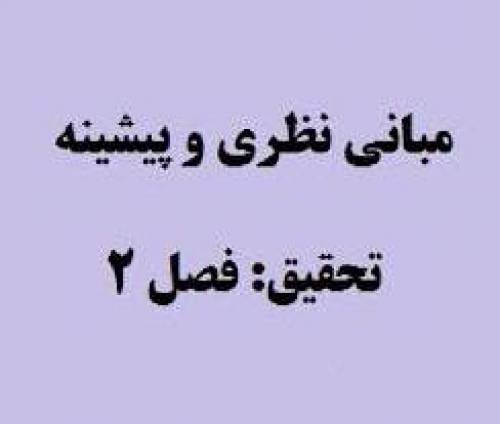فروشگاه بلبل فایل
پاورپوینت مبانی نظری و پیشینه تحقیق طرح توجیهی پروژه مهندسی نرم افزار کارآموزی






مبانی نظری و پیشینه تحقیق سلامت روانی
فرمت : doc
تعداد صفحات : 40
مبانی نظری و پیشینه تحقیق سلامت روانی
بخشی از متن :
تاريخچه سلامت روانی
تاريخچه سلامت رواني با توجه به وجود بيماريهاي رواني از زماني که بشر وجود داشته و مخصوصاً از زمانی که زندگي اجتماعي را شروع کرده با او همراه بوده است. پيدا کردن شروع يک نهضت به خصوص نهضتهاي اصلاحي و علمي به علت داشتن منابع گوناگون و چند جانبه مسأله مشکلي است. در حقيقت روان پزشکي را ميتوان قديميترين حرفه و تازهترين علم به شمار آورد. قديميترين، چون بيماريهاي رواني از قديم وجود داشتهاند. تازهترين علم، براي اينکه تقريباً از سال 1930، بعد از تشکيل اولين کنگرهي بينالمللي بهداشت رواني بود که روانپزشکي جزئي از علوم پزشکي شد و سازمانهاي روان پزشکي و مراکز پيشگيري در کشورهاي مترقي يکي بعد از ديگري فعاليت خود را شروع کردند. از فعاليت اين سازمانها در جريان جنگ جهاني دوم عملاً کاسته شد و بدين ترتيب ميتوان روانپزشکي را تازهترين علم بعد از جنگ جهاني دوم به حساب آورد (ساپینگتون[1]،2006).
اولين بار سقراط فيلسوف مشهور يوناني بود که خرافات را از بيماريهاي رواني کنار گذاشت و اختلالات رواني را به طرف پزشکي کشانيد. دربارهي ماليخوليا و جنون زايماني تعريف و توصيف کرد و مغز را مرکز اصلي روان دانست. جاليوس علت اصلي بيماريهاي رواني را اختلال عمل مغز و عدم تعادل اخلاط بدن ميدانست. در اوايل قرن 13 و اوايل رنسانس ارتباط جسم و روان و يکپارچگي واکنش آنها مورد بحث قرار گرفت و به علاوه فرضيه ابوعليسينا مسأله اين ارتباط را به اسپانيا و کشورهاي ديگر کشاند و اين زمينهاي براي فرضيه ی جديد بيماريهاي روان تني شد. اين قرن را بايد قرن سحر و جادو، دخالت شياطين و ارواح در ايجاد بيماريهاي رواني دانست (میلانی فر،1386).
اطلاعات جسته گريختهاي وجود دارد که تا قرن 14 براي مواظبت و نگهداري بيماران رواني مکاني در مونت کاسينوي[2] ايتاليا، بيمارستاني در ليون فرانسه و در پاريس، بيمارستان بتلعه در لندن که در سال 1247 بنا شد (اولين بيمارستان تقريباً رسمي و دولتي) و در سال 1385 بيمارستان بارتولومو[3] در لندن در نزديکي کليساي سنت بارتولومو وجود داشته است. در اسپانيا اولين بيمارستان رواني در سال 1409 در شهر والنسيا[4] به وسيلهي يک کشيش اسپانيايي ايجاد شد و علت آن رفتار استهزا آميز و آزاردهندهي افراد نسبت به بيماران رواني در ملأ عام بوده است. در قرن 17 ارتباط جسم و روان و محل اين ارتباط در سلسله اعصاب مورد بحث قرار گرفت و دکارت[5] و مالپي ويليس[6] و سايرين مراکزي براي اين ارتباط تعيين کردند. در همين قرن در سال 1602 اولين کتاب پزشکي دربارهي بيماريهاي رواني به نام پراکيس مديا[7] توسط يک پزشک سوئيسي نوشته شد که در آن طبقهبندي بيماري رواني مورد توجه قرار گرفت و براي اين بيماريها علل ارگانيک قائل شدند.در قرن 18 مسأله به همان طريق قرن 17 ادامه يافت و مؤسسات خيريه در کشورهاي کاتوليک بنا به پيشنهاد کشيشها تأسيس شد. در اواخر قرن 18 و اوايل قرن 19 نام سه نفر در سولوحهي پيشتازان و رهبران درمان اخلاقي و انساني قرار دارد که عبارتند از: فيليپ نيپل از فرانسه[8]، ويليام تيوک[9] از انگلستان و ول سنزوکياروگي[10] از ايتاليا (میلانی فر،1386).
در قرن بيستم باب پردازش تئوريهاي مختلف روانکاوي، روانپزشکي ديناميک، ژنتيک، بيولوژي، ارتباط جسم و روان، تئوريهاي سرشتي، مطالعه دربارهي آثار الکترو شوک و عمل جراحي مغز در بعضي از بيماريهاي رواني، گشايش مراکز اورژانس روان پزشکي به علت بروز جنگ جهاني دوم و مطالعات اپيدميولوژيک در کودکاني که از خانوادههايشان جدا و به ساير کشورها مخصوصاً سوئيس آورده شده بودند، باز شد. کم کم مکتب رفتارگرايي توسط واتسون، مفهوم همئوستازي و مطالعهي واکنشهاي اعصاب اتونوم بر اثر برخورد با استرسها و فشارها به وسيلهي کانن[11]، تئوري هيجان به وسيله جيمز پاپز[12]، فرضيه فشار و سندرم سازش عمومي توسط هانس سليه و بالاخره فرضيههاي ديگر يکي پس از ديگري پيدا شد و روان پزشکي به صورت روان پزشکي امروزي درآمد(ساپینگتون، 2006).
در سال 1930 اولين کنگرهي بينالمللي بهداشت رواني با شرکت نمايندگان پنجاه کشور در واشنگتن تشکيل شد و مسائل رواني کشورها از قبيل تأسيس بيمارستانها، مراکز درماني سرپايي، مراکز کودکان عقبمانده ذهني و نظاير آن مورد مطالعه قرار گرفت. در سومين کنگرهي بينالمللي بهداشت رواني در سال 1948 که در لندن تشکيل شد اساس فدراسيون جهاني بهداشت رواني بنيانگذاري شد و در همان سال اين فدراسيون به عضويت رسمي سازمان يونسکو[13] و سازمان بهداشت جهاني درآمد و اين سازمان در ژنو نقش رهبري رسمي فدراسيون جهاني بهداشت رواني را به عهده گرفت. در سال 1960 به دستور پرزيدنت کندي رئيس جمهور وقت آمريکا قوانين جديدي براي بهداشت رواني وضع شد و دولت عهدهدار مسؤوليتهاي سنگيني براي اين گونه بيماران شد. در سال 1952 اولين راهنماي تشخيص آماري بيماريهاي رواني که داراي تقسيمبندي و تعريف اختلالات رواني بود منتشر شد ولي مورد موافقت اکثر روانپزشکان کشورهاي اروپايي و آمريکايي قرار نگرفت. در سال 1968 دومين راهنماي تشخيص و آماري بيماران رواني با دقت بيشتري در تقسيمبندي، تعاريف و اختلالات رواني منتشر شد که مورد تأييد بيشتر روانپزشکان قرار گرفت(ساراسون، 2003). در بين سالهاي 1983 تا 1987 در کشورهاي آمريکا، فرانسه، اسرائيل، ايتاليا، آلمان و ونزوئلا مسألهي ژنتيکي بودن بيماريهاي رواني مورد توجه قرار گرفت و ژنهاي بعضي از بيماريها از جمله بيماري کره هانتيگتون[14] و آلزايمر فاميلي[15] و ژن مشخصکننده دو نوع مختلف و مجزاي اختلالات خلقي دوقطبي کشف شد. در سال 1994 چهارمين راهنماي تشخيص و آماري بيماريهاي رواني منتشر شد و فعلا مورد استفادهي روانپزشکان و مراکز روان پزشکي در تمام کشورهاي دنيا است (ميلانيفر، 1386).
مبانی نظری و پیشینه تحقیق سلامت روانی
[1] . Sappington
[2] . Mount Cassion
[3] . Bartholomew’s
[4] . Valencia
[5] . Decartes
[6] . Malpighi willis
[7] . Perayix media
[8] . Philippe piner
[9] . William Tuke
[10] . Vencenzo chiarugi
[11] . Cannon
[12] . Jems Papze
[13] . Unesco
[14] . Huntington chorea
[15] . Alzheimer’s ctisease
مبانی نظری و پیشینه تحقیق سلامت روانی
منابع فارسی:
آجیل چی، ب. (1387). تأثیر آموزش مهارتهای فرزندپروری در کاهش تنیدگی مادران و فرزندان و افزایش حرمت خود کودکان. پایاننامه کارشناسی ارشد. دانشکده روانشناسی و علوم تربیتی، دانشگاه علامه طباطبائی.
خرازی، پریسا. (1380). بررسی رابطه بین شیوههای فرزندپروری مادران و عزت نفس کودکان مبتلا به اختلالات یادگیری. پایان نامه کارشناسی ارشد. دانشگاه آزاد اسلامی، واحد تهران مرکز.
ذاکری رازلیقی، مرضیه. (1384). بررسی رابطه ابزارگری هیجانی و کنترل هیجانی با شادکامی. پایان نامه کارشناسی ارشد. دانشگاه الزهرا، تهران دانشکده روان شناسی وعلوم تربیتی.
کاظمیان مقدم، کبری، و مهرابی زاده هنرمند، مهناز .(1388). . روانشناسی و دین، سال دوم، شماره چهارم، ص 157-174
منابع غیر فارسی
Akinboye, J. (2002). Correlates of Testing Time, Age and Sex in the Nigerians, Performance on the Torrance Test of Creativity. Journal of Psychological Research. 26, 1-5.
Aaron Resch, J, Gerardo Mireles, Michael R. Benz, Cheryl Grenwelge, Rick Peterson, Dalun Zhang. (2010). Giving Parents a Voice: A Qualitative Study of the Challenges Experienced by Parents of Children With Disabilities. Rehabilitation Psychology, Volume 55, Issue 2,, Pages 139-150.
Avid, E., Griffin,C., & Brough, S. (2000). Parents` construction of the "problem" during assessment and diagnosis of their child for an autistic spectrum disorder. Journal of Health Psychology, 5 (2), 241-245.
Baas, M, Carsten K. W. & Nijstad, A.(2011). When Prevention Promotes Creativity: The Role of Mood, Regulatory Focus, and Regulatory Closure. Journal of Personality & Social Psychology; Vol. 100 Issue 5, p794-809, 16p.
Bartlet, T. M. C. (2005). Factor associated with attachment in international adoptation. Unpublishing Doctorate Thesis. Kansas State University: USA.
aumrind, D. (1991). The influence of parenting style on adolescent competence and substance use. Journal of early adolescence, 11, 56-95.
Baumrind, D. (1991). The influence of parenting style on adolescent competence and substance use. Journal of early adolescence, 11, 56-95.
Baxter, C., Cummins, R. A., & Yiolitis, L. (2000). Parental stress attributed to disabled family members: A longitudinal study. Journal ofDevelopmental Disability, 25(2), 105-119.
Benson, P. R. (2010). Coping, distress, and well-being in mothers of children with autism. Research in Autism Spectrum Disorders. 4 (2), 217–228.
Brobst, J.B., Clopton, J.R, Hendrick, S.S. (2009). Parenting children with autism spectrum disorders: The couple’s relationship. Focus on Autism and Other Developmental Disabilities, 24(1), 38-49.
Cantor, N. and Sanderson, C. A. (1999). Life task participation and well-being: The importance of taking part in daily life. New York, US.: Russell Sage Foundation.
Coplan, R. J., reichel, M., rowan, K. (2009). Exploring the associations between maternal personality, child temperament, and parenting: A focus on emotions. Personality and Individual Differences. 46 :241–246
Corsini , R . J.(2005). Handbook of Innovative Therapy.John wiley and sons Inc.
Costa, P. T., and McCrae, R. R. (2005). Influence of extroversion and neuroticism on subjective well-being: happy and unhappy people. J. Pers. Soc. Psychol., 38, 668-678.
Cox W. M. and Klinger, Eric, (2011). Handbook of motivational counseling: Goal-Based Approaches to Assessment and Intervention with Addiction and Other Problems, Second Edition. John Wiley & Sons.
Darling, N. (1999). Parenting style and its correlates. ERIC Digest. Champaign, IL: ERIC Clearinghouse on Elementary and Early Childhood Education. (ERIC Document No. ED427896). Also available: http://ericeece.org/pubs/digests/1999/darlin99.html
Enten, R. S. & Golan, M. (2009). Parenting styles and eating disorder pathology. Journal of Appetite.52 : 784-787.
Estes, A., Munson, J., Dawson, G., Kohler, E., Zhou, X., Abbott, R. (2009). Parenting stress and psychological functioning among mothers of preschool children with autism and developmental delay. Autism, 13(4), 375-387.
Fayers PM, Machin D. (2000). Quality of Life Assessment, Analysis and Interpretation, John Willy, New York.
Glasgow, K.L., Dornbusch, S.M., Troyer, L., Steinberg, L. & Ritter, P.L. (1997). Parental styles, adolescent’s attributions, and educational outcomes in nine heterogeneous high schools. Child development, 68, 3: 507-529.
Gibson, J.L., Ivancevich, J.M. and Donnelly, J.H. (2004). Organizations: Behavior, Structure, processes. (10 th ed). NewYork: MCGrow- Hill/ Irwin.
Hastings, R. P., Kovshoff, H., Ward, N. J., Espinosa, F., Brown, T., & Remington, B. (2005). Systems analysis of stress and positive perceptions in mothers and fathers of pre-school children with autism. Journal of Autism and Developmental Disorders, 35(5), 635-644.
Haycraft, E. & blissett, J. (2010). Eating disorder symptoms and parenting styles. Journal of Appetite. 54: 221-224.
Herring S., Gray K., Taffe J., Tonge B., Sweeney D. & Einfeld S. (2006) Behaviour and emotional problems in toddlers with pervasive developmental disorders and developmental delay: associations with parental mental health and family functioning. Journal of Intellectual Disability Research, 50(12), 874–882.
Higgins, D. J., Bailey, S.R., & Pearce, J. C. (2005). Factors associated with functioning style and coping strategis of families with a child with autism spectrum disorder. Sage Publications and the National Autism Society, 9(2), 125-137.
Kaplan, M. and Maddux. J.E. (2002). Goals and Marital Satisfaction: Perceived Support for Personal and Collective Efficacy for Collective Goal. Journal of Social and Clinical Psychology, 21(2) , 157- 164.
King, C. R., & et al. (2006). Quality of life from nursing and patient perspective. theory , research, practice .Boston :john and Bartlett.
Kroodsma, L. (2007). An educational workshop for parents of children with Asperger Syndrome. . Dissertation Abstracts International. (ProQuest document).
Katanin, S. et al. (2001). Childhood temprement and mother’s child rearing attitude. European Journal of personality. Vol 17 p. 249-265.
Keang Ieng,V (2008).Developing creativity and promoting social harmony: the relationship between government, school and parents’ perceptions of children’s creativity in Macao-SAR in China, Early Years, Vol. 28, No. 2, July 2008, 149–158.
Lazarus, R. S. & Folkman, S. (1984). Stress, appraisal and coping. New York: Springer.
Mash, E.J., & Johnston, C. (1990). Determinations of parenting stress: Illustrations from families of hyperactive children and families of physically abused children. Journal of Clinical Child Psychology, 19(4), 313-328.
Miller, M. & Gerard, d. (2005). Family influence in the development of creativity in children, Journal of Personality and Social Psychology, 66, 950-967.
Onder, A. & Gulay, H. (2009). Reliability and validity of parenting styles & dimensions questionnaire. Procedia Social and Behavioral Sciences,1 : 508-514.
Rodgers, A. Y. (1998). Multiple sources of stress and parenting behavior. Children and Youth Services Review, 20(6), 525-546.
Seijts, H., Lattam, G. P. ,Tasa, A., and Lattam, B. W. (2004). Goal setting and goal orientation: An integration of two different yet related literatures. Academy of management Journal, 47, 227- 249.
Sheldon, K. M. & Houser – Marko.( 2001). Self concordance goale attainment and the pursuit of happiness: can there be an uward spiral? Journal of Personality and Social Psychology, 80, 152- 162.
Webester-Stratton, C. (1990). Stress: A potential disruptor of parent perception and family interactions. Journal of Clinical Child Psychology, 19(4), 302-312.
Pratt, M. W. (2003). Mothers and fathers teaching 3-yearolds: Authoritative parenting and adult scaffolding of young children's learning. Developmental Psychology, 36, 6, 832-839.
Towe-Goodman, N. R., & Teti, D. M. (2008). Power assertive discipline, maternal emotional involvement, and child adjustment. Journal of Family Psychology, 22,648–651.
Xie, Q. (2004). Parenting style and children's school achievement in China., New York. (ERIC Document Reproduction Service No. ED396819).
| salamat_ravani_1546446780_2766_1635_1821.zip0.06 MB |
